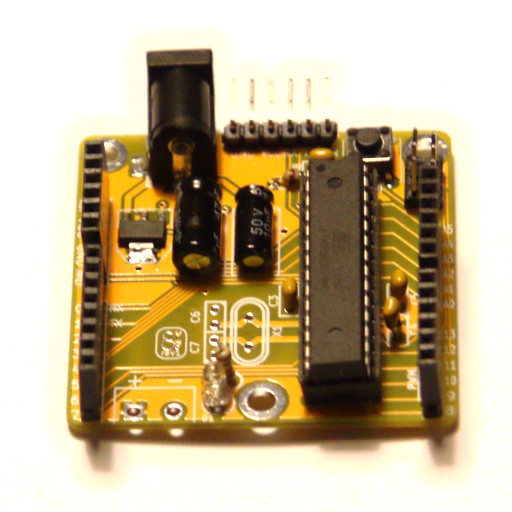For the past week, I have been looking into assembler programming, specifically for the AVR series. I have really been enjoying Gerhard Schmidt's AVR assembler tutorial, which seems very thorough.
I tried to implement the blink example, and maybe went a little overboard. The usual reasons for using assembler programming instead of C is optimizing timing and/or program size. My results: the final program is 44 bytes in binary form, and each led change is (or should be) exactly 16 million cycles, which is one second on a 16MHz clock. The program can of course be modified for other clock speeds and blinking intervals - up to 65535 millisecond per blink.
This is compared to the arduino blink example, which is 1084 bytes and precise only to the millisecond (If I remember correctly).
I am totally new in assembler programming, and if you find a mistake, please tell me!
I have ordered some attiny13a's, and made some small development boards for them. But more on that later!
The code:
; My first piece of assembler code. It is made to mimic the blink
; example from the Arduino environment. The arduino example compiles
; to around 1Kb - this is 44 bytes. And should be very
; precise in the timing.
.nolist;
.include "m88def.inc";
.list;
; SETTING CLOCK SPEED - currently at 16 MHz
.equ clockCyclesPerMilliSecond = 16*1000
; The delay to put between blinks in milliseconds
.equ delayMilliseconds = 1000
; The direction register, the port and the bit to set the pin of the
; LED to flash
; Currently at PB5 (Arduino pin 13)
.equ DDR = DDRB
.equ PORT = PORTB
.equ BIT = 5
; SETTING UP REGISTERS
.DEF my_register = R16
; Not sure if this is needed... It works without it.
rjmp setup
; setup
setup:
SBI DDR,BIT ; Set pin to output
loop:
sbi PORT,BIT ; 2 cycles - set pin HIGH
rcall Delay ; 3 cycles (the call itself)
cbi PORT,BIT ; 2 cycles - set pin LOW
rcall Delay ; 3 cycles (the call itself)
rjmp loop ; 2 cycles (the jump itself) - repeat
Delay:
nop
; Delay consists of two loops - the inner loop loops for a
; millisecond, the outer counts the number of milliseconds-
; From every inner loop, there is subtracted the number of
; cycles to complete the outer loop (8). From the first time, there
; is also subtracted the number of cycles to call, setup and return
; from the subroutine as well as the cycles for switching the pin,
; half of the rjmp command and the nop in the start of this function
; inner loop : 4 cycles
; outer loop : 8 cycles
; pin switching, calling, returning and looping : 16 cycles
; Since precision is made by cutting the number of times the
; inner loop runs, it is important that the number of cycles
; in the outer loop and the one-time-fluff is divisble by 4.
ldi ZH,HIGH((clockCyclesPerMilliSecond-8-16)/4)
ldi ZL,LOW((clockCyclesPerMilliSecond-8-16)/4)
; A lot of nops and grief could be saved by only supporting a
; maximum of 255 millisecond delay.
ldi YL,LOW(delayMilliseconds)
ldi YH,HIGH(delayMilliseconds)
delayloop:
sbiw ZL, 1 ; 2 cycles
brne delayloop ; 2 cycles
sbiw YL,1 ; 2 cycles
ldi ZH,HIGH((clockCyclesPerMilliSecond-8)/4) ; 1 cycle
ldi ZL,LOW((clockCyclesPerMilliSecond-8)/4) ; 1 cycle
nop ; added to make a number of cycles divisible by 4 1 cycle
nop ; added to make a number of cycles divisble by 4 1 cycle
brne delayloop ; 2 cycles
nop ; added to make a number of cycles divisible by 4 ; 1 cycle
ret ; 3 cycles

